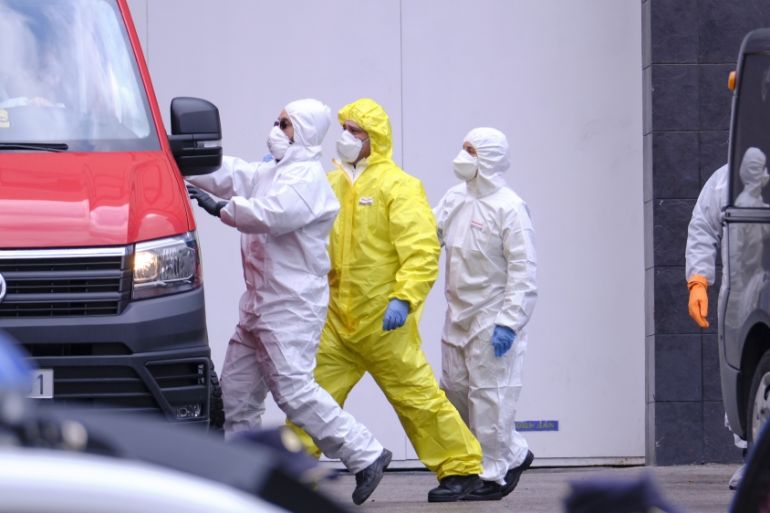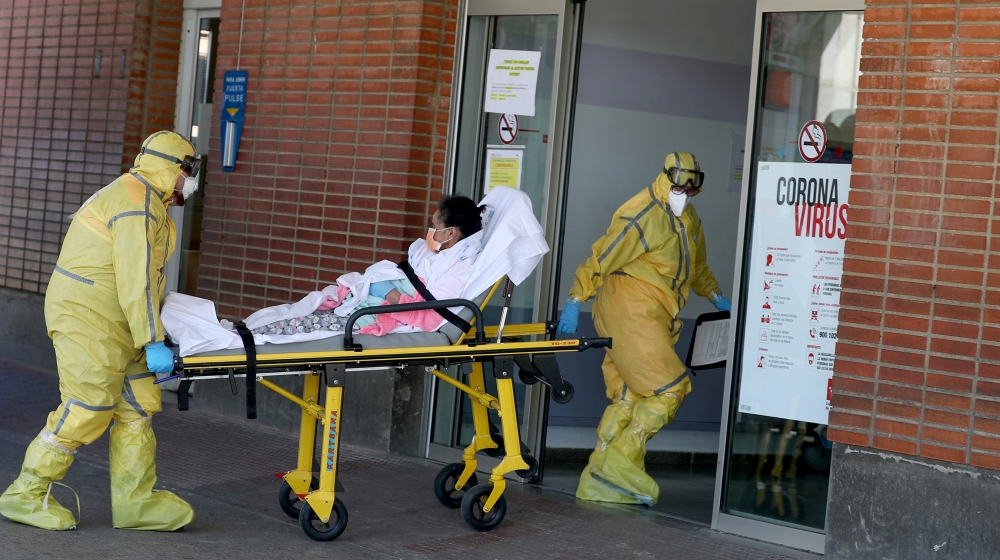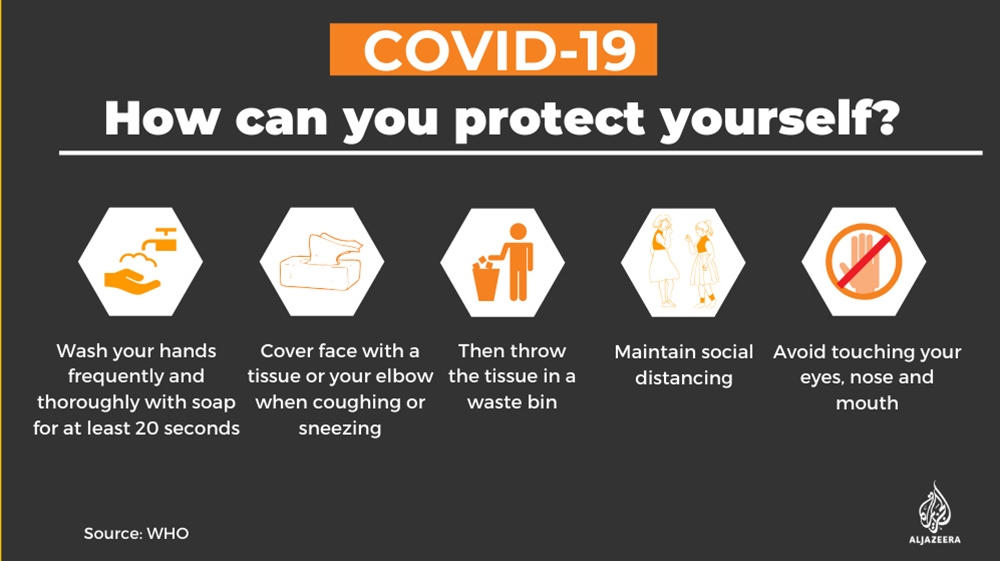Coronavirus: Why are deaths rising so quickly in Spain?
Experts say large elderly population, social behaviour and weak healthcare system have contributed to high fatalities.

Editor’s note: This article was first published on March 27, 2020. To view the latest figures related to the coronavirus, visit this page.
Granada, Spain – Every night in Spain since the coronavirus state of alert was decreed on March 14, citizens take a moment to applaud the country’s beleaguered medical workers.
Keep reading
list of 3 itemsSpain reports 769 new deaths but says daily rise stabilising
Timeline: How the new coronavirus spread
But this hopeful image does little to dim the pain of the pandemic; Spain’s daily death toll reached a harrowing new high of 769 on Friday, bringing the total number of fatalities to almost 5,000.
Fresh cases of coronavirus-related infections did drop, from a record total on Thursday of 8,578 to 7,871 on Friday.
But both numbers are far worse than a week ago, when new cases stood at 2,833.
Another unnerving fact is that compared with Italy, where eight percent of health workers are affected, in Spain by Friday that tally stood at 16.5 percent.
What has caused such a rapid spread of coronavirus in Spain?
Multiple factors
The most high-profile reason touted by the media in Spain is the public health service’s uneven and reportedly depleted resources for tackling this, or indeed any, kind of virus-related pandemic.
Academics in Spain partly confirm this as one possible reason, but underline multiple other factors.
“As recently as Wednesday, the Centre for Disease Prevention and Control in Europe pointed out that the impact of COVID-19 depended on a country’s level of preparation and its ability to implement rapid countermeasures,” Silvia Carlos Chilleron, a professor in the department of Public Health and Preventive Medicine at the University of Navarra, told Al Jazeera.
“If the increase in cases has been fast, as it has been in Spain, and the human and material resources to fight it are not guaranteed, then the impact is more serious. That probably causes a greater number of deaths among the most vulnerable sectors of society, particularly when medical professionals are among those affected.”
Also on Wednesday, Spain’s State Confederation of Medical Unions (CESM) lodged a case with the country’s Supreme Court, asking the health ministry to provide sufficient protective equipment as soon as possible.
CESM alleged in their case, which was rejected, that the ministry had so far failed to provide professional health workers with sufficient protection to carry out their work in a manner that reduces the risk of catching coronavirus.
“People are generally respecting the lockdown and trying not to come into hospitals for minor illnesses and that’s helping reduce the risk of contagion,” one hospital doctor in southern Spain, who did not wish to be named for fear of reprisals, told Al Jazeera.
“But there is a lack of sanitary material in the hospitals for this kind of crisis, which multiplies the possibilities of health staff getting contagious infections, and that’s going to be a huge factor.”
|
|
Underlying reasons for the coronavirus spread before the state of alert could have been “the low level of perception among the population at large that coronavirus represented a risk”, Jose Hernandez, a researcher and assistant professor of sociology at the University of Cordoba, whose specialties include social health policies, told Al Jazeera.
At that point and “until relatively recently, there wasn’t enough information on what coronavirus was”, he said.
Spanish population distribution may also have an effect, observed Alberto Mataran, a professor of Environmental Sciences at the University of Granada.
“There’s a huge density of people in cities like Madrid or on the Mediterranean coast in particular, and a lot of blocks of flats in cities’ outlying suburbs.
“Add in a lot of communal spaces, a very affectionate kind of social behaviour compared to some countries – we always shake hands, or hug, or kiss each other, when we meet, for example – and the opportunities for propagation surely could increase, too.”
As for the much-cited dearth of resources, Hernandez argued it explains the “relatively rapid saturation” of the health services.
“Also, Spain has a large elderly population, who are very vulnerable, and retirement homes do not, generally, have massive medical resources.
“On top of that, the fact that Spain’s hospitals and medical services are run by different autonomous regions creates some very important underlying inequalities.”

Hernandez added that while regional governments can demand assistance from Madrid, this does raise the risk of poorly judged medical strategy decisions in the central government.
In 2014, medical staff in Madrid protested against the lack of effective protective equipment and safety precautions amid the Ebola epidemic.
“We could see that the public health system had some big gaps in the early detection of infections. And these are structural weaknesses,” he said.
Fast-track testing
Meanwhile, the government had to defend its decision to allow demonstrations in Spain on International Women’s Day on March 8, something that professor Silvia Carlos Chilleron flagged as a possible factor.
“The greater the number of contacts, the greater the probability of contagion, particularly when it’s a new infection against which we have no immunity,” she said.
She also pointed to the unusually mild spring and the higher levels of socialisation – people sitting outside in bars and so on – as another possibility, while warning that studies have yet to resolve whether a rise in temperature and higher humidity may act as a brake on the virus’s propagation.

Over the past few days, the national conversation has focused on testing – a dearth of verifiable, rapid methods to establish the true extent of the spread of coronavirus.
The government’s much-vaunted purchase of millions of fast-track tests from China and elsewhere partly backfired this week when it was discovered that the initial batch of 9,000 had very limited reliability.
Although the Spanish government insists the problem will be resolved with further purchases of more reliable tests, most have yet to arrive.
Carlos Chilleron said polymerase chain reaction (PCR) testing, which takes between four and six hours to produce results and is being used by 20,000 people a day in Spain, was the most reliable method.
According to the Live Science website, PCR tests work by “detecting specific genetic material within the virus. Depending on the type of PCR on hand, healthcare workers might swab the back of the throat; take a saliva sample; collect a liquid sample from the lower respiratory tract; or secure a stool sample.”
Quicker tests that take a fraction of the time are less precise and as a result, and “we don’t have the same kind of security from them that a person is not affected”, said Carlos Chilleron.
She recommends social distancing and hygiene as the best precautions in the absence of testing.
In Spain, as the death toll rises, there are currently rumours that lockdown measures will be tightened further.
Rumours are also circulating that should a peak not be reached soon and cases start to fall, lockdown measures will be toughened up even further.
As the full scale of the pandemic has yet to emerge, knowing what measures are needed is looking increasingly hard to judge.